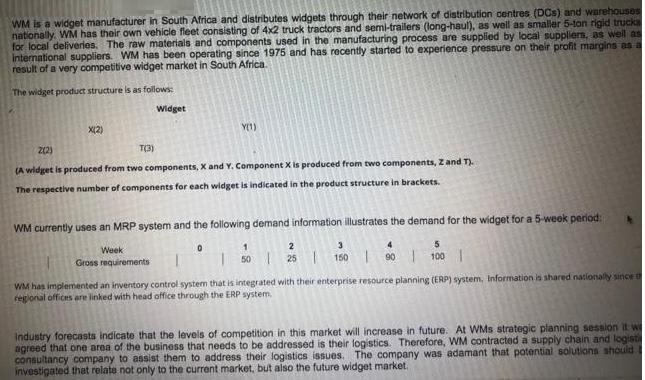Question
The widget product structure is as follows: Widget X(2) Y(1) Z(2) T(3) (A widget is produced from two components, X and Y. Component X is

The widget product structure is as follows:
Widget
X(2) Y(1)
Z(2) T(3)
(A widget is produced from two components, X and Y. Component X is produced from two components, Z and T).
The respective number of components for each widget is indicated in the product structure in brackets.
WM currently uses an MRP system and the following demand information illustrates the demand for the widget for a 5-week period:
Week 0 1 2 3 4 5
Gross requirements 50 25 150 90 100
The company obtains component X from a supplier in Gauteng. The supplier has offered the following quantity discount:
Purchase cost R20/unit (orders below 200 units), lead time 1 week
Purchase cost R15/unit (orders 200 units and more), lead time 2 weeks
Currently WM orders 130 units at a time. The following additional costs apply:
Order cost R500/order
Weekly inventory carrying cost R5/unit
Use the additional information to complete MRP matrices to decide whether to accept the offer of the supplier with respect to component X:
Inventory on-hand 150 components
Scheduled receipt 50 components in week 3
WM is a widget manufacturer in South Africa and distributes widgets through their network of distribution centres (DCs) and warehouses nationally. WM has their own vehicle fleet consisting of 4x2 truck tractors and semi-trailers (long-haul), as well as smaller 5-ton rigid trucks for local deliveries. The raw materials and components used in the manufacturing process are supplied by local suppliers, as well as international suppliers. WM has been operating since 1975 and has recently started to experience pressure on their profit margins as a result of a very competitive widget market in South Africa. The widget product structure is as follows: Widget X(2) 2(2) T(3) (A widget is produced from two components, X and Y. Component X is produced from two components, Z and T). The respective number of components for each widget is indicated in the product structure in brackets. Y(1) WM currently uses an MRP system and the following demand information illustrates the demand for the widget for a 5-week period: Week Gross requirements 0 I 2 25 | 1 1 50 3 4 150 1 90 1 5 100 | WM has implemented an inventory control system that is integrated with their enterprise resource planning (ERP) system, Information is shared nationally since regional offices are linked with head office through the ERP system. Industry forecasts indicate that the levels of competition in this market will increase in future. At WMs strategic planning session it w agreed that one area of the business that needs to be addressed is their logistics. Therefore, WM contracted a supply chain and logisti consultancy company to assist them to address their logistics issues. The company was adamant that potential solutions should investigated that relate not only to the current market, but also the future widget market.
Step by Step Solution
3.43 Rating (153 Votes )
There are 3 Steps involved in it
Step: 1
To determine whether to accept the suppliers offer for component X we need to calculate the net requirements planned receipts and planned order releases for each week based on the demand and inventory ...
Get Instant Access to Expert-Tailored Solutions
See step-by-step solutions with expert insights and AI powered tools for academic success
Step: 2

Step: 3

Ace Your Homework with AI
Get the answers you need in no time with our AI-driven, step-by-step assistance
Get Started


